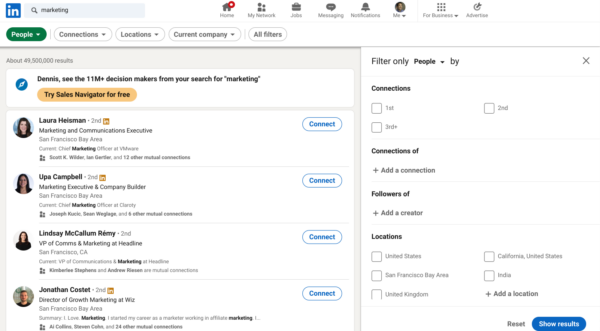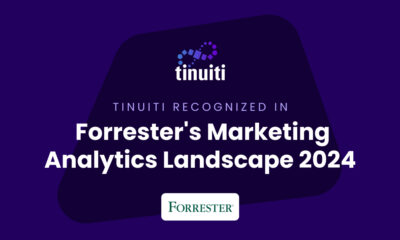MARKETING
Unlock Audience Personas With the Power of LinkedIn
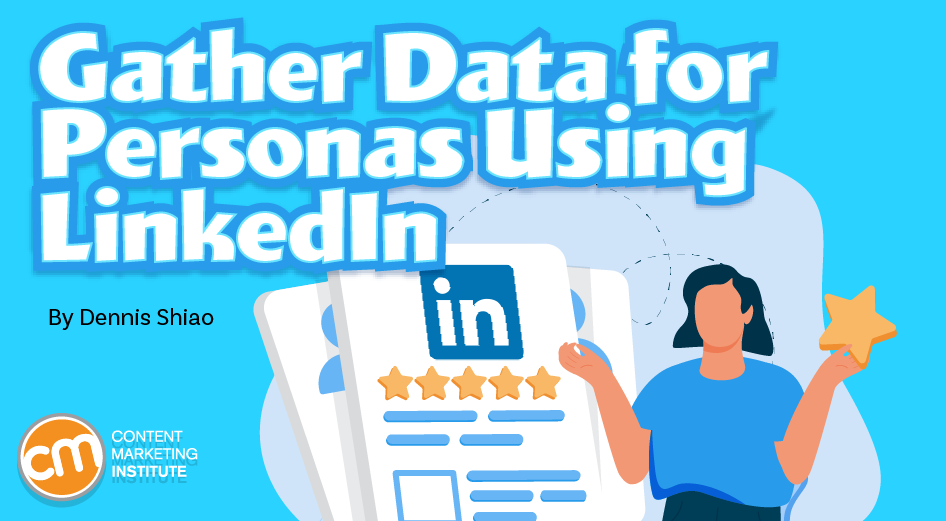
I failed.
I helped a client with an account-based marketing (ABM) initiative. We had third-party intent data of companies searching keywords and phrases related to their services. We also had the LinkedIn profiles of those companies’ employees – people who would be likely buyers.
I analyzed the LinkedIn profiles to identify buying signals. Did they post asking about vendor capabilities? Did they ask for vendor recommendations? Or did they request proposals?
The result of my work?
Nothing. None of those LinkedIn profiles signaled that type of buying intent.
While the process failed to deliver actionable results for my client, it better informed my ability to provide well-developed personas to create more effective content marketing.
Researching LinkedIn profiles can provide a wealth of insights. In this post, I show you what you can uncover.
@LinkedIn profiles can provide a wealth of insights about audience personas, says @Dshiao via @CMIContent. Click To Tweet
Finding your personas on LinkedIn
You first need to generate a list of people to research. Enter a broad descriptive term in the search bar. I usually start with “marketing.”
From there, click on “people” and “all filters.” It returns over 49.5 million results:
Next to the results view are the filter options – a lot of them, including:
- Connections (i.e., degree of connection to your profile)
- Locations
- Talks about
- Current company
- Past company
- School
- Industry
- Profile language
- Open to
- Service categories
- Keywords
Choose the filters based on the nature of your research. For instance, if you focus on a Middle East-based audience, use the locations filter accordingly. Pick “current company” to research people at targeted companies.
To find people in specific roles, filter for title (under the keywords filter). Then type the job title in quotes, such as “senior procurement manager.”
To research B2B content marketers, I typed B2B and “content marketers” into the title search field:
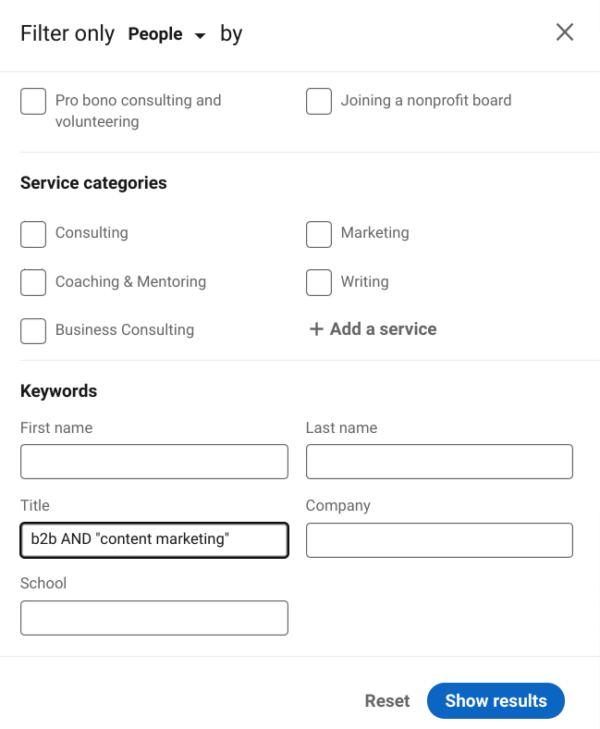
You can create a broad or niche list depending on your filter criteria.
Research LinkedIn profiles
Now that you compiled a list of people, you can assess which ones will be most helpful to your research and identify other profiles to add to your tracker.
Skim past the underpopulated profiles and spend your time on the detailed ones. Give them a glance from top to bottom. Don’t focus solely on the About or Activity sections at the top. The bottom of the profile – volunteering, recommendations, publications, and honors and awards – can reveal interesting nuggets.
Spend research time on detailed @LinkedIn profiles, perusing their information from top to bottom, says @Dshiao via @CMIContent. Click To Tweet
Use one profile to find more people from the same persona. Much the same way a hyperlink in an article takes the reader to a related article, LinkedIn users provide pathways to profiles from the same persona. Convenient widgets to check on a user’s profile page include “people you may know” and “people also viewed.”
Now, let’s walk through section by section to identify their relevancy and potential insights.
Headline
The headline is listed under their name on the profile page. It also appears when you browse the LinkedIn feed. While many list their job title and organization, others see the headline as an opportunity to make a statement or to stand out.
Think of these custom headlines as a clue that tells you a bit about the person’s missions, motivations, and ambitions. That information can help your understanding of the audience persona they represent.
Let’s consider a few examples of different personas taken from existing profiles, along with the lesson learned:
|
Functional Role |
Headline |
Takeaway |
| Product management | Entrepreneur with passion for developing great products that solve real-world customer challenges | The importance product managers place in having their products solve real-world challenges |
| Product management | Passionate about creating software users love, and working with good people to build them | Idea: Explore the concept that product managers want to work with “good people” to build products. |
| Entrepreneur | Make video content 10x faster for better marketing, comms, and client services | Understand the tangible goal of the product, as well as common use cases. |
| Digital health leader | Growth Focused Commercial Digital Health Leader Committed to Transforming Patient Care with Novel Solutions | Making Big, Innovative Ideas Actionable for >25 Years | The tenure mentioned is interesting. This digital health leader strives to make an impact over the long term. |
| Engineering leader | People are any company’s biggest asset; I pride myself on putting people first. ex Twilio, Microsoft, Komodo Health | A leader of software engineering teams who places her team first |
| Social media marketer | Building stronger relationships through effective content and social media marketing | It’s not all about impressions, shares and likes, it’s also about relationships |
About
LinkedIn users have 2,600 characters to describe themselves in the “about” section. This free-form area only allows plain text – no special formatting, images, or clickable links. The detailed description of their roles and responsibilities can help build a better picture of their associated persona. Let’s look at two examples.
A detailed about section on a @LinkedIn profile can help build a better picture of the associated persona, says @Dshiao via @CMIContent. Click To Tweet
Cristina Crespo is vice president of product at Paytient. The first sentence of her about section concisely explains what product management leaders do: “Product management leader with more than 10 years of experience ideating and launching technology solutions that solve real problems and achieve business outcomes.”

She further describes her comfort with ambiguity and creative mindset “to identify quick wins and a roadmap that evolves through constant learning and experimentation.” Next, Cristina explains how she’s helped organizations achieve revenue growth and includes this bulleted list:
- Conducting qualitative research to identify customer insights
- Articulating the problem and business opportunity
- Defining a compelling product vision and strategy
- Prioritizing solutions and defining a clear go-to-market strategy
- Facilitating iterative design and rapid prototyping with continuous validation
- Testing new product ideas in market with a fail-fast approach
- Measuring and using data to inform product decisions
- Meaningfully growing products to address pain points and market needs
If your audience persona is product managers or product management leaders, this list gives a good sense of their activities.
Next, let’s look at Bernie Borges, vice president of global content marketing at iQor. In his about section, Bernie details his activities and goals:
- Lead the strategy to produce relevant content that represents iQor accurately.
- Represent iQor’s core values through storytelling and case studies.
- Empower iQor Business Development to create more sales conversations through relevant content.
- Enable iQor recruiters to source more candidates through relevant content.
- Inform prospective iQor customers to learn how we can drive CX results for them.
- Give iQor customers insight into where we’re headed in the future.
- Help Inform the analyst community of insights into our CX capabilities.
- Host the Digitally Irresistible video podcast from iQor.
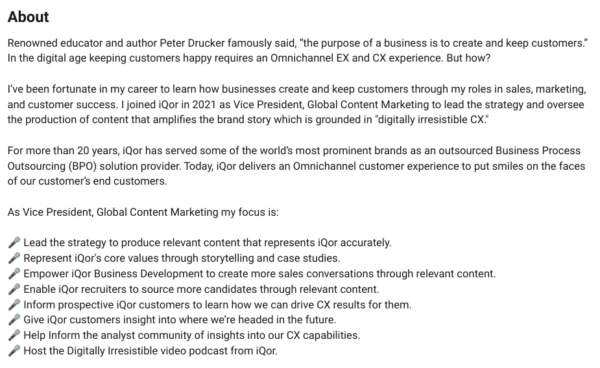 If your company sells a product for content marketing teams, you can learn from Bernie’s list what a content marketing leader does. You can brainstorm blog posts, e-books, and webinar topics that assist someone like Bernie with these activities or help them achieve some of these goals.
If your company sells a product for content marketing teams, you can learn from Bernie’s list what a content marketing leader does. You can brainstorm blog posts, e-books, and webinar topics that assist someone like Bernie with these activities or help them achieve some of these goals.
Featured
Featured is an optional area that enables LinkedIn users to prominently display their LinkedIn posts, newsletter, and articles, as well as external links and uploaded media.
Brett Durrett is director of product management at Google. Brett’s featured section includes a number of SlideShare presentations from his time at IMVU, including:
- Continuous Deployment at Lean LA
- Learning Fast With A/B Testing and Continuous Deployment
- Lean Startup Pitfalls Uncovered
- Building a Successful Business After Launch
- Leveraging Open Source Software to Maximize Your Development Resources (and the problems you can expect with success)
In each entry, Brett describes the presentation, such as this one for Building a Successful After Launch:
GDC Online 2010 presentation of how IMVU built its product after launching. Includes examples of the testing/experiment systems, reporting, continuous deployment, and process improvement.
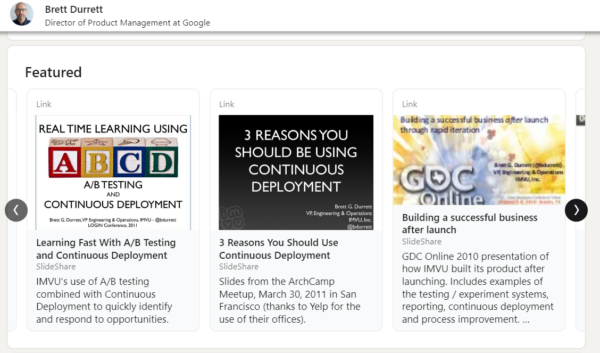
If you’re researching the senior vice president of engineering persona, reviewing Brett’s presentations tells you a lot about that role and, in particular, specific attributes of that role at IMVU.
Experience (job detail)
In the experience section, users list their employment history, including job title, organization name, years worked, location, and job details.
A localization program manager at a technology company provided this nugget in her job detail:
Drove $1.4M in cost savings, together with a 20% time-saving, leveraging scalable automation, cross-team process improvement, and company-wide operational efficiencies. This includes utilizing the latest localization technology, workflow automation to reduce manual efforts, and overhauling creative processes for faster time-to-market.
In just two sentences, you learn:
- The quantifiable impacts of her team’s efforts
- The technology she used
- The processes or process changes she implemented
- Additional benefits achieved (e.g., reduced manual efforts, faster time-to-market)
If you create content for localization program managers, you could look to see if your customers have achieved similar results, then interview them to learn more. With those findings, you might conceive a content campaign that shows other localization program managers how they can achieve similar results.
Experience (associated media)
When providing details on a current or past job, LinkedIn lets you add media, such as an image, video, or slide deck, as I did with my presentation 10 Quick Tips for Effective Content Marketing in the example below:
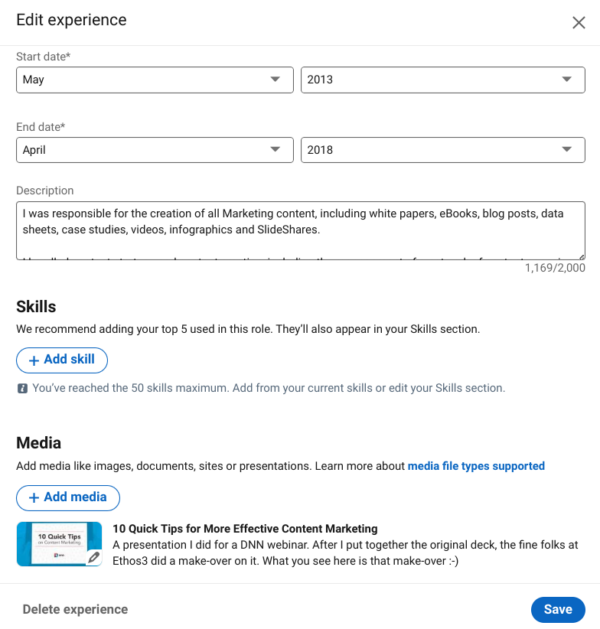
Lisa Gately is a principal analyst at Forrester. She was a senior director of content strategy at Genesys. In that listing, Lisa linked to an article, Confessions of a Content Strategist: Lisa Gately, based on an interview she did with Ahava Leibtag, who published the article on her LinkedIn profile.
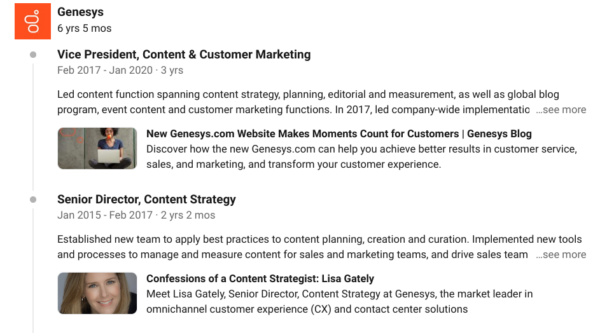
The article details what a content strategist does. Some of the questions Lisa answered include:
- How did you get started in content strategy?
- How did you formalize your role as a content strategist in your current environment?
- What was your number one challenge in getting the content strategy team up and running?
- What do you see happening in the future of content?
That interview provides a wealth of information about content strategists and the industry.
Activity
The activity section groups together posts, comments, videos, images, articles, newsletters, and more. Navigate across the tabs to look for interesting things. I like to peek at comments to discover new people to research. After all, someone in one audience persona is likely to engage with other users from the same persona.
Jose Palomares is the director of localization at Coupa Software. In his profile’s posts, he shared industry webinars on which he was a panelist, including the Globalization and Localization Association’s webinar on headless systems:
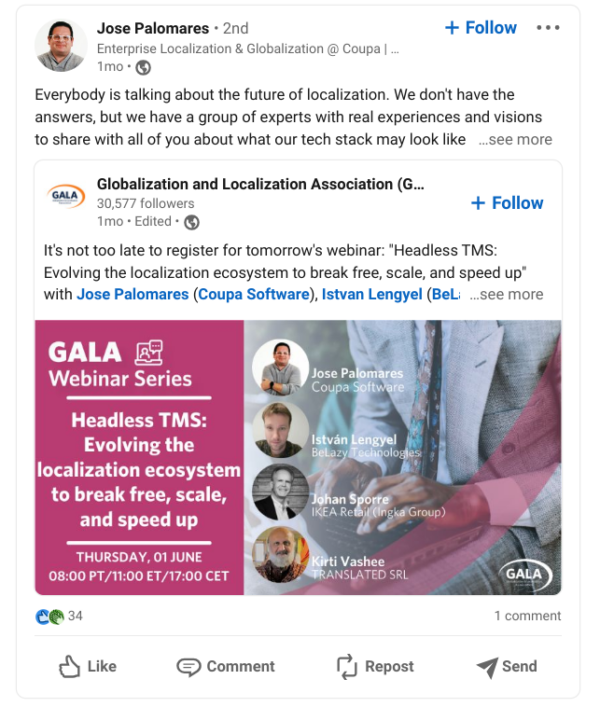
If your persona was a director of localization, watching the on-demand recordings of these webinars would be helpful. You also can think about whether the webinar topics should be added to your editorial calendar.
Groups (mutual)
LinkedIn users also can add organizations to which they belong in the groups section. Their profiles don’t list all the groups to which they belong. However, the highlights section indicates groups you have in common.
When I visit Rich Schwerin’s profile, I see we have six groups in common, including the Content Marketing Institute and The Content Wrangler Community.
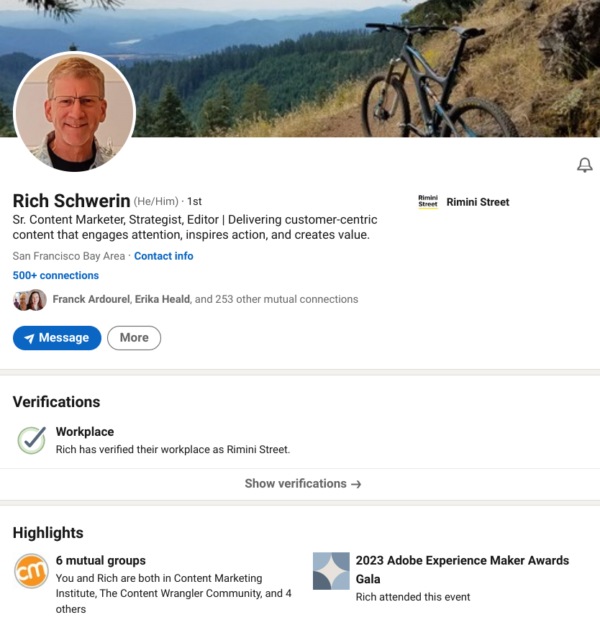
Find relevant LinkedIn groups, visit them, and see what users are posting about. Through Scott Abel’s The Content Wrangler Community, I noticed this post from Heather Hedden about her appearance at Lava Con, a conference for content strategists:

Recommendations
LinkedIn recommendations can be useful because they may detail how a person was exceptional or useful within the context of the role you’re researching. Karen Budell is the chief marketing officer at Totango. When she was vice president of brand marketing at Momentive.ai, she received a recommendation from her boss, Leela Srinivasan:

Here’s an excerpt of the recommendation relevant to Karen’s role in brand marketing:
She brought every ounce of her strategic marketing brain to the table as my partner in crime on the complex and sensitive rebrand of a public company with a global footprint. She adeptly managed multiple agency relationships, helped steer the executive team through a mountain of change, and proved to be a clutch player throughout the journey. She is super smart about creating impactful content and experiences.
With these details, you learn brand marketing executives lead organizations through rebrands, which requires them to navigate agency relationships, as well as relationships with their executive team.
Go deep into LinkedIn profiles
LinkedIn hosts an ocean of information on your audience personas. It also requires no financial investment. You can hit the highlights or go down the rabbit hole of connected research to craft helpful audience research.
Please share in the comments some of the tricks you’ve used in doing persona research on LinkedIn.
HANDPICKED RELATED CONTENT:
Cover image by Joseph Kalinowski/Content Marketing Institute
MARKETING
Tinuiti Marketing Analytics Recognized by Forrester
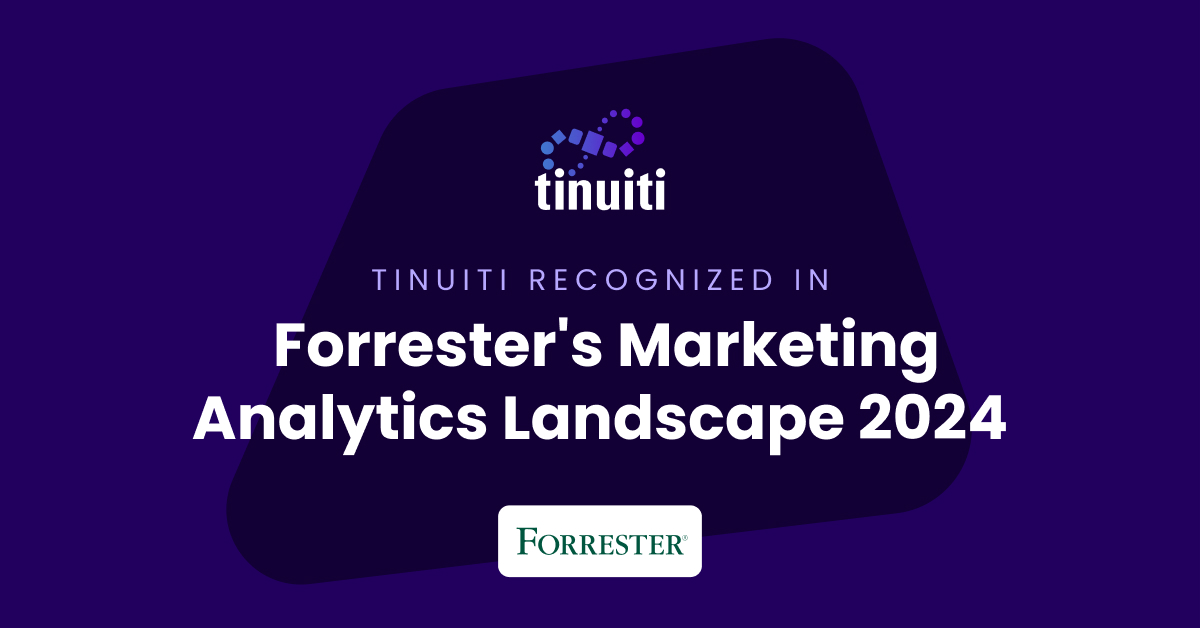
Rapid Media Mix Modeling and Proprietary Tech Transform Brand Performance
Tinuiti, the largest independent full-funnel performance marketing agency, has been included in a recent Forrester Research report titled, “The Marketing Analytics Landscape, Q2 2024.” This report comprehensively overviews marketing analytics markets, use cases, and capabilities. B2C marketing leaders can use this research by Principal Analyst Tina Moffett to understand the intersection of marketing analytics capabilities and use cases to determine the vendor or service provider best positioned for their analytics and insights needs. Moffett describes the top marketing analytics markets as advertising agencies, marketing dashboards and business intelligence tools, marketing measurement and optimization platforms and service providers, and media analytics tools.
As an advertising agency, we believe Tinuiti is uniquely positioned to manage advertising campaigns for brands including buying, targeting, and measurement. Our proprietary measurement technology, Bliss Point by Tinuiti, allows us to measure the optimal level of investment to maximize impact and efficiency. According to the Forrester report, “only 30% of B2C marketing decision-makers say their organization uses marketing or media mix modeling (MMM),” so having a partner that knows, embraces, and utilizes MMM is important. As Tina astutely explains, data-driven agencies have amplified their marketing analytics competencies with data science expertise; and proprietary tools; and tailored their marketing analytics techniques based on industry, business, and data challenges.
Our Rapid Media Mix Modeling sets a new standard in the market with its exceptional speed, precision, and transparency. Our patented tech includes Rapid Media Mix Modeling, Always-on Incrementality, Brand Equity, Creative Insights, and Forecasting – it will get you to your Marketing Bliss Point in each channel, across your entire media mix, and your overall brand performance.
As a marketing leader you may ask yourself:
- How much of our marketing budget should we allocate to driving store traffic versus e-commerce traffic?
- How should we allocate our budget by channel to generate the most traffic and revenue possible?
- How many customers did we acquire in a specific region with our media spend?
- What is the impact of seasonality on our media mix?
- How should we adjust our budget accordingly?
- What is the optimal marketing channel mix to maximize brand awareness?
These are just a few of the questions that Bliss Point by Tinuiti can help you answer.
Learn more about our customer-obsessed, product-enabled, and fully integrated approach and how we’ve helped fuel full-funnel outcomes for the world’s most digital-forward brands like Poppi & Toms.
The Landscape report is available online to Forrester customers or for purchase here.
MARKETING
Ecommerce evolution: Blurring the lines between B2B and B2C
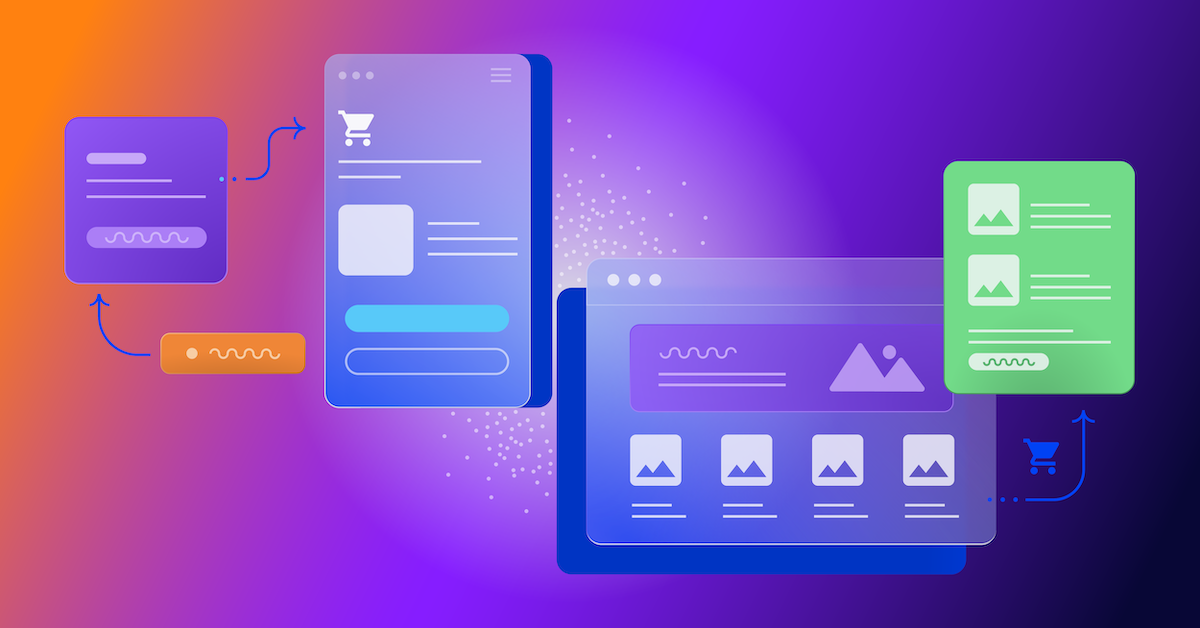
Understanding convergence
B2B and B2C ecommerce are two distinct models of online selling. B2B ecommerce is between businesses, such as wholesalers, distributors, and manufacturers. B2C ecommerce refers to transactions between businesses like retailers and consumer brands, directly to individual shoppers.
However, in recent years, the boundaries between these two models have started to fade. This is known as the convergence between B2B and B2C ecommerce and how they are becoming more similar and integrated.
Source: White Paper: The evolution of the B2B Consumer Buyer (ClientPoint, Jan 2024)
What’s driving this change?
Ever increasing customer expectations
Customers today expect the same level of convenience, speed, and personalization in their B2B transactions as they do in their B2C interactions. B2B buyers are increasingly influenced by their B2C experiences. They want research, compare, and purchase products online, seamlessly transitioning between devices and channels. They also prefer to research and purchase online, using multiple devices and channels.
Forrester, 68% of buyers prefer to research on their own, online . Customers today expect the same level of convenience, speed, and personalization in their B2B transactions as they do in their B2C interactions. B2B buyers are increasingly influenced by their B2C experiences. They want research, compare, and purchase products online, seamlessly transitioning between devices and channels. They also prefer to research and purchase online, using multiple devices and channels
Technology and omnichannel strategies
Technology enables B2B and B2C ecommerce platforms to offer more features and functionalities, such as mobile optimization, chatbots, AI, and augmented reality. Omnichannel strategies allow B2B and B2C ecommerce businesses to provide a seamless and consistent customer experience across different touchpoints, such as websites, social media, email, and physical stores.
However, with every great leap forward comes its own set of challenges. The convergence of B2B and B2C markets means increased competition. Businesses now not only have to compete with their traditional rivals, but also with new entrants and disruptors from different sectors. For example, Amazon Business, a B2B ecommerce platform, has become a major threat to many B2B ecommerce businesses, as it offers a wide range of products, low prices, and fast delivery
“Amazon Business has proven that B2B ecommerce can leverage popular B2C-like functionality” argues Joe Albrecht, CEO / Managing Partner, Xngage. . With features like Subscribe-and-Save (auto-replenishment), one-click buying, and curated assortments by job role or work location, they make it easy for B2B buyers to go to their website and never leave. Plus, with exceptional customer service and promotional incentives like Amazon Business Prime Days, they have created a reinforcing loyalty loop.
And yet, according to Barron’s, Amazon Business is only expected to capture 1.5% of the $5.7 Trillion addressable business market by 2025. If other B2B companies can truly become digital-first organizations, they can compete and win in this fragmented space, too.”
If other B2B companies can truly become digital-first organizations, they can also compete and win in this fragmented space
Joe AlbrechtCEO/Managing Partner, XNGAGE
Increasing complexity
Another challenge is the increased complexity and cost of managing a converging ecommerce business. Businesses have to deal with different customer segments, requirements, and expectations, which may require different strategies, processes, and systems. For instance, B2B ecommerce businesses may have to handle more complex transactions, such as bulk orders, contract negotiations, and invoicing, while B2C ecommerce businesses may have to handle more customer service, returns, and loyalty programs. Moreover, B2B and B2C ecommerce businesses must invest in technology and infrastructure to support their convergence efforts, which may increase their operational and maintenance costs.
How to win
Here are a few ways companies can get ahead of the game:
Adopt B2C-like features in B2B platforms
User-friendly design, easy navigation, product reviews, personalization, recommendations, and ratings can help B2B ecommerce businesses to attract and retain more customers, as well as to increase their conversion and retention rates.
According to McKinsey, ecommerce businesses that offer B2C-like features like personalization can increase their revenues by 15% and reduce their costs by 20%. You can do this through personalization of your website with tools like Product Recommendations that help suggest related products to increase sales.
Focus on personalization and customer experience
B2B and B2C ecommerce businesses need to understand their customers’ needs, preferences, and behaviors, and tailor their offerings and interactions accordingly. Personalization and customer experience can help B2B and B2C ecommerce businesses to increase customer satisfaction, loyalty, and advocacy, as well as to improve their brand reputation and competitive advantage. According to a Salesforce report, 88% of customers say that the experience a company provides is as important as its products or services.
Market based on customer insights
Data and analytics can help B2B and B2C ecommerce businesses to gain insights into their customers, markets, competitors, and performance, and to optimize their strategies and operations accordingly. Data and analytics can also help B2B and B2C ecommerce businesses to identify new opportunities, trends, and innovations, and to anticipate and respond to customer needs and expectations. According to McKinsey, data-driven organizations are 23 times more likely to acquire customers, six times more likely to retain customers, and 19 times more likely to be profitable.
What’s next?
The convergence of B2B and B2C ecommerce is not a temporary phenomenon, but a long-term trend that will continue to shape the future of ecommerce. According to Statista, the global B2B ecommerce market is expected to reach $20.9 trillion by 2027, surpassing the B2C ecommerce market, which is expected to reach $10.5 trillion by 2027. Moreover, the report predicts that the convergence of B2B and B2C ecommerce will create new business models, such as B2B2C, B2A (business to anyone), and C2B (consumer to business).
Therefore, B2B and B2C ecommerce businesses need to prepare for the converging ecommerce landscape and take advantage of the opportunities and challenges it presents. Here are some recommendations for B2B and B2C ecommerce businesses to navigate the converging landscape:
- Conduct a thorough analysis of your customers, competitors, and market, and identify the gaps and opportunities for convergence.
- Develop a clear vision and strategy for convergence, and align your goals, objectives, and metrics with it.
- Invest in technology and infrastructure that can support your convergence efforts, such as cloud, mobile, AI, and omnichannel platforms.
- Implement B2C-like features in your B2B platforms, and vice versa, to enhance your customer experience and satisfaction.
- Personalize your offerings and interactions with your customers, and provide them with relevant and valuable content and solutions.
- Leverage data and analytics to optimize your performance and decision making, and to innovate and differentiate your business.
- Collaborate and partner with other B2B and B2C ecommerce businesses, as well as with other stakeholders, such as suppliers, distributors, and customers, to create value and synergy.
- Monitor and evaluate your convergence efforts, and adapt and improve them as needed.
By following these recommendations, B2B and B2C ecommerce businesses can bridge the gap between their models and create a more integrated and seamless ecommerce experience for their customers and themselves.
MARKETING
Streamlining Processes for Increased Efficiency and Results

How can businesses succeed nowadays when technology rules? With competition getting tougher and customers changing their preferences often, it’s a challenge. But using marketing automation can help make things easier and get better results. And in the future, it’s going to be even more important for all kinds of businesses.
So, let’s discuss how businesses can leverage marketing automation to stay ahead and thrive.
Benefits of automation marketing automation to boost your efforts
First, let’s explore the benefits of marketing automation to supercharge your efforts:
Marketing automation simplifies repetitive tasks, saving time and effort.
With automated workflows, processes become more efficient, leading to better productivity. For instance, automation not only streamlines tasks like email campaigns but also optimizes website speed, ensuring a seamless user experience. A faster website not only enhances customer satisfaction but also positively impacts search engine rankings, driving more organic traffic and ultimately boosting conversions.
Automation allows for precise targeting, reaching the right audience with personalized messages.
With automated workflows, processes become more efficient, leading to better productivity. A great example of automated workflow is Pipedrive & WhatsApp Integration in which an automated welcome message pops up on their WhatsApp
within seconds once a potential customer expresses interest in your business.
Increases ROI
By optimizing campaigns and reducing manual labor, automation can significantly improve return on investment.
Leveraging automation enables businesses to scale their marketing efforts effectively, driving growth and success. Additionally, incorporating lead scoring into automated marketing processes can streamline the identification of high-potential prospects, further optimizing resource allocation and maximizing conversion rates.
Harnessing the power of marketing automation can revolutionize your marketing strategy, leading to increased efficiency, higher returns, and sustainable growth in today’s competitive market. So, why wait? Start automating your marketing efforts today and propel your business to new heights, moreover if you have just learned ways on how to create an online business
How marketing automation can simplify operations and increase efficiency
Understanding the Change
Marketing automation has evolved significantly over time, from basic email marketing campaigns to sophisticated platforms that can manage entire marketing strategies. This progress has been fueled by advances in technology, particularly artificial intelligence (AI) and machine learning, making automation smarter and more adaptable.
One of the main reasons for this shift is the vast amount of data available to marketers today. From understanding customer demographics to analyzing behavior, the sheer volume of data is staggering. Marketing automation platforms use this data to create highly personalized and targeted campaigns, allowing businesses to connect with their audience on a deeper level.
The Emergence of AI-Powered Automation
In the future, AI-powered automation will play an even bigger role in marketing strategies. AI algorithms can analyze huge amounts of data in real-time, helping marketers identify trends, predict consumer behavior, and optimize campaigns as they go. This agility and responsiveness are crucial in today’s fast-moving digital world, where opportunities come and go in the blink of an eye. For example, we’re witnessing the rise of AI-based tools from AI website builders, to AI logo generators and even more, showing that we’re competing with time and efficiency.
Combining AI-powered automation with WordPress management services streamlines marketing efforts, enabling quick adaptation to changing trends and efficient management of online presence.
Moreover, AI can take care of routine tasks like content creation, scheduling, and testing, giving marketers more time to focus on strategic activities. By automating these repetitive tasks, businesses can work more efficiently, leading to better outcomes. AI can create social media ads tailored to specific demographics and preferences, ensuring that the content resonates with the target audience. With the help of an AI ad maker tool, businesses can efficiently produce high-quality advertisements that drive engagement and conversions across various social media platforms.
Personalization on a Large Scale
Personalization has always been important in marketing, and automation is making it possible on a larger scale. By using AI and machine learning, marketers can create tailored experiences for each customer based on their preferences, behaviors, and past interactions with the brand.
This level of personalization not only boosts customer satisfaction but also increases engagement and loyalty. When consumers feel understood and valued, they are more likely to become loyal customers and brand advocates. As automation technology continues to evolve, we can expect personalization to become even more advanced, enabling businesses to forge deeper connections with their audience. As your company has tiny homes for sale California, personalized experiences will ensure each customer finds their perfect fit, fostering lasting connections.
Integration Across Channels
Another trend shaping the future of marketing automation is the integration of multiple channels into a cohesive strategy. Today’s consumers interact with brands across various touchpoints, from social media and email to websites and mobile apps. Marketing automation platforms that can seamlessly integrate these channels and deliver consistent messaging will have a competitive edge. When creating a comparison website it’s important to ensure that the platform effectively aggregates data from diverse sources and presents it in a user-friendly manner, empowering consumers to make informed decisions.
Omni-channel integration not only betters the customer experience but also provides marketers with a comprehensive view of the customer journey. By tracking interactions across channels, businesses can gain valuable insights into how consumers engage with their brand, allowing them to refine their marketing strategies for maximum impact. Lastly, integrating SEO services into omni-channel strategies boosts visibility and helps businesses better understand and engage with their customers across different platforms.
The Human Element
While automation offers many benefits, it’s crucial not to overlook the human aspect of marketing. Despite advances in AI and machine learning, there are still elements of marketing that require human creativity, empathy, and strategic thinking.
Successful marketing automation strikes a balance between technology and human expertise. By using automation to handle routine tasks and data analysis, marketers can focus on what they do best – storytelling, building relationships, and driving innovation.
Conclusion
The future of marketing automation looks promising, offering improved efficiency and results for businesses of all sizes.
As AI continues to advance and consumer expectations change, automation will play an increasingly vital role in keeping businesses competitive.
By embracing automation technologies, marketers can simplify processes, deliver more personalized experiences, and ultimately, achieve their business goals more effectively than ever before.
-

 SEARCHENGINES6 days ago
SEARCHENGINES6 days agoGoogle Core Update Volatility, Helpful Content Update Gone, Dangerous Google Search Results & Google Ads Confusion
-
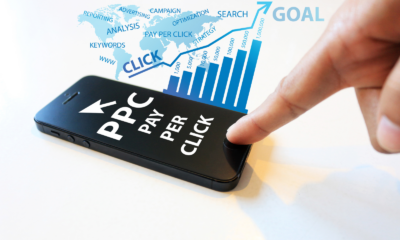
 SEO6 days ago
SEO6 days ago10 Paid Search & PPC Planning Best Practices
-

 MARKETING7 days ago
MARKETING7 days ago2 Ways to Take Back the Power in Your Business: Part 2
-
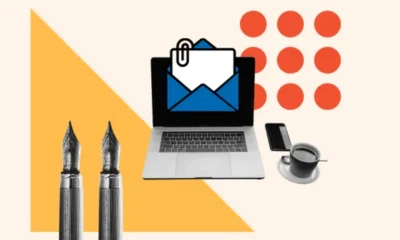
 MARKETING5 days ago
MARKETING5 days ago5 Psychological Tactics to Write Better Emails
-

 SEARCHENGINES5 days ago
SEARCHENGINES5 days agoWeekend Google Core Ranking Volatility
-

 PPC7 days ago
PPC7 days agoCritical Display Error in Brand Safety Metrics On Twitter/X Corrected
-

 MARKETING6 days ago
MARKETING6 days agoThe power of program management in martech
-
SEARCHENGINES4 days ago
Daily Search Forum Recap: April 15, 2024

